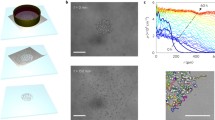Abstract
This paper proposes a three-dimensional diffuse interface dynamic model with multiple mechanisms and confirms the high possibility of adequate predictions. In particular, we consider the nucleus that exhibits three-dimensional motion in the crawling cell, which enables a more realistic representation of haptotactic migration. A diffuse interface model that incorporates the haptotaxis mechanism and interface energies is employed. The semi-implicit Fourier spectral scheme is adopted for efficient evaluation of the simulation model. The simulation results confirm the reliability of the developed model.
Similar content being viewed by others
References
Adler, J. A method for measuring chemotaxis and use of the method to determine optimum conditions for chemotaxis by Escherichia coli. J. Gen. Microbiol. 74, 77–91 (1973).
Zigmond, S.H. Ability of polymorphonuclear leukocytes to orient in gradients of chemotactic factors. J. Cell Biol. 75, 606–616 (1977).
Robert, D.N., Paul, G.Q. & Richard, L.S. Chemotaxis under agarose: A new and simple method for measuring chemotaxis and spontaneous migration of human polymorphonuclear leukocytes and monocytes. J. Immunol. 115, 1650–1656 (1975).
Lauffenburger, D.A., Rothman, C. & Zigmond, S.H. Measurement of leukocyte motility and chemotaxis parameters with a linear under-agarose migration assay. J. Cell Biol. 131, 940–947 (1983).
Tranquillo, R.T., Zigmond, S.H. & Lauffernburger, D.A. Measurement of the chemotaxis coefficient for human-neutrophils in the under-agarose migration assay. Cell Motil. Cytoskel. 11, 1–15 (1988).
Berg, H. How to track bacteria. Rev. Sci. Instrum. 42, 868–871 (1971).
Diao, J.P. A three-channel microfluidic device for generating static linear gradients and its application to the quantitative analysis of bacterial chemotaxis. Lab. Chip 6, 381–388 (2006).
Rot, A. Neutrophil attractant activation protein-1 (interleukin-8) induces invitro neutrophil migration by haptotactic mechanism. Eur. J. Immunol. 23, 303–306 (1993).
Webb, L.M.C. et al. Binding to heparan-sulfate or heparin enhances neutrophil responses to interleukin-8. Proc. Natl. Acad. Sci. USA 90, 7158–7162 (1993).
Webster, R.O., Zanolari, B. & Henson, P.M. Neutrophil chemotaxis in response to surface-bound C5A. Exp. Cell Res. 129, 55–62 (1980).
Wilkinson, P.C. & Allan, R.B. Chemotaxis of leucocytes towards substratum-bound protein attractants. Exp. Cell Res. 117, 403–412 (1978).
Keller, E.F. Model for chemotaxis. J. Theor. Biol. 30, 225–234 (1971).
Murray, J.D. Mathematical Biology. Springer-Verlag, New York (1993).
Tracqui, P. From passive diffusion to active cellular migration in mathematical models of tumour invasion. Acta Biotheor. 43, 443–464 (1995).
Lu, W. & Kim, D. Thin-film structures induced by electrostatic field and substrate kinetic constraint. Appl. Phys. Lett. 88, 153116 (2006).
Kim, D. Computational analysis of the interfacial effect on electromigration in flip chip solder joints. Microelectron. Eng. 86, 2132–2137 (2009).
Kim, D. & Lu, W. Self-organized nanostructures in multi-phase epilayers. Nanotech. 15, 667–674 (2004).
Kim, D. & Lu, W. Creep flow, diffusion, and electromigration in small scale interconnects. J. Mech. Phys. Solids 54, 2554–2568 (2006).
Kim, D. & Lu, W. Three-dimensional model of electrostatically induced pattern formation in thin polymer films. Phys. Rev. B. 73, 035206 (2006).
Lu, W. & Kim, D. Patterning nanoscale structures by surface chemistry. Nano Lett. 4, 313–316 (2004).
Lu, W. & Kim, D. Engineering nanophase self-assembly with elastic field. Acta Mater. 53, 3689–3694 (2005).
Song, J.H. & Kim, D. Three-dimensional chemotaxis model for a single bacterium. J. Comput. Theor. Nanos. 6, 1687–1693 (2009).
Ganiko, L. et al. Neutrophil haptotaxis induced by the lectin KM+. Glycoconjugate J. 15, 527–530 (1998).
Smith, J.T., Elkin, J.T. & Reichert, W.M. Directed cell migration on fibronectin gradients: Effect of gradient slope. Exp. Cell Res. 312, 2424–2432 (2006).
Zhang, L., Song, J. & Kim, D. A study on cancer-cell invasion based on multi-physics analysis technology. BioChip J. 4, 161–165 (2010).
Cahn, J.W. Free energy of a nonuniform system.1. Interfacial free energy. J. Chem. Phys. 28, 258–267 (1958).
Alber, M. et al. Multiscale dynamics of biological cells with chemotactic interactions: From a discrete stochastic model to a continuous description. Phys. Rev. E. 73, 051901 (2006).
Cahn, J.W. Free energy of a nonuniform system. 1. Interfacial free energy. J. Chem. Phys. 28, 258–267 (1958).
Author information
Authors and Affiliations
Corresponding author
Rights and permissions
About this article
Cite this article
Song, J., Kim, D. Development of three-dimensional haptotaxis model for single crawling cell. BioChip J 4, 184–188 (2010). https://doi.org/10.1007/s13206-010-4304-8
Received:
Accepted:
Published:
Issue Date:
DOI: https://doi.org/10.1007/s13206-010-4304-8




